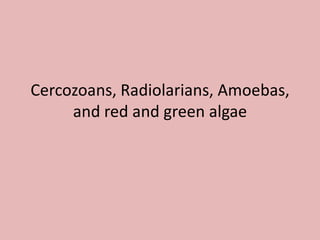
Cercozoans, Radiolarians, Amoebas, And Red
- 1. Cercozoans, Radiolarians, Amoebas, and red and green algae
- 2. Cercozoans This is a newly formed clade. It contains a diversity of amoebas, which have been defined as eukaryotic cells containing pseudopodia, or thread like extensions that bulge from the cell surface. Radiolarians are a newly formed clade, closely related the cercozoans, they also have pseudopodia nut test made of silica instead organic compounds. Both are water dwelling.
- 3. Examples Globigerina Radiolarian The test (shell) gathers at bottom of oceans to form thick ooze
- 4. Amoebazoans This clade contains what we traditionally refer to as amoebas, such as gymnamoebasand entamoebas. This clade also contains slime molds.
- 5. Gymnamoebas This traditional view of an amoeba has lobe shaped pseudopodia instead of thread like pseudopdia instead of the thread like pseudopodia of cercozoans and radiolarians. They are ubiquitous; they live on land and sea. Mostly they heterotrophs, actively seeking and consuming bacteria
- 7. Entamoebas These are parasites, unlike your typical amoeba which is free roaming. They infect all forms of vertebrates. Entamoebahistolytica
- 8. Slime Molds These are split into two groupings: Plasmodial slime molds Cellular slime molds Both have typical amoeba behaviors The difference between these two lies in their distinctive life cycles. In which Plasmodial slime molds spend most of their life in an diploid stage; Cellular slime mold a haploid stage.
- 9. Plasmodial Slime life cycle
- 10. Cellular Slime life cycle
- 11. Examples
- 12. Red algae and green algae These are the closest relatives to land plants. They arose due to endosymbiosis, which means a heterotrophic protistaquired a bacterial symbiont that used photosynthesis.
- 13. Red algae Contains red pigment due to it needing to collect blue and green light for photosythesis. Its pigment can change though depending on depth. This protist is located in warm coastal water of tropical oceans. They are multicellular.
- 14. Example
- 15. Green algae They are very close relatives of land plans. These are split up into two groups: Chlorophytes Charophyceans They can multicellular or unicellular. They are usually seen in freshwater as plankton, but they can be more plant like.
- 16. Green Algae Levels of Complexity Formation of single cell colonies. (simplest) Repeated division of nuclei with no cytoplasmic division. (more complex) Finally a true multicellular organism with cell division and cell differentation. (most complex
- 17. Examples Ulva: Most complex Caulerpa: more complex Volvox: simplest